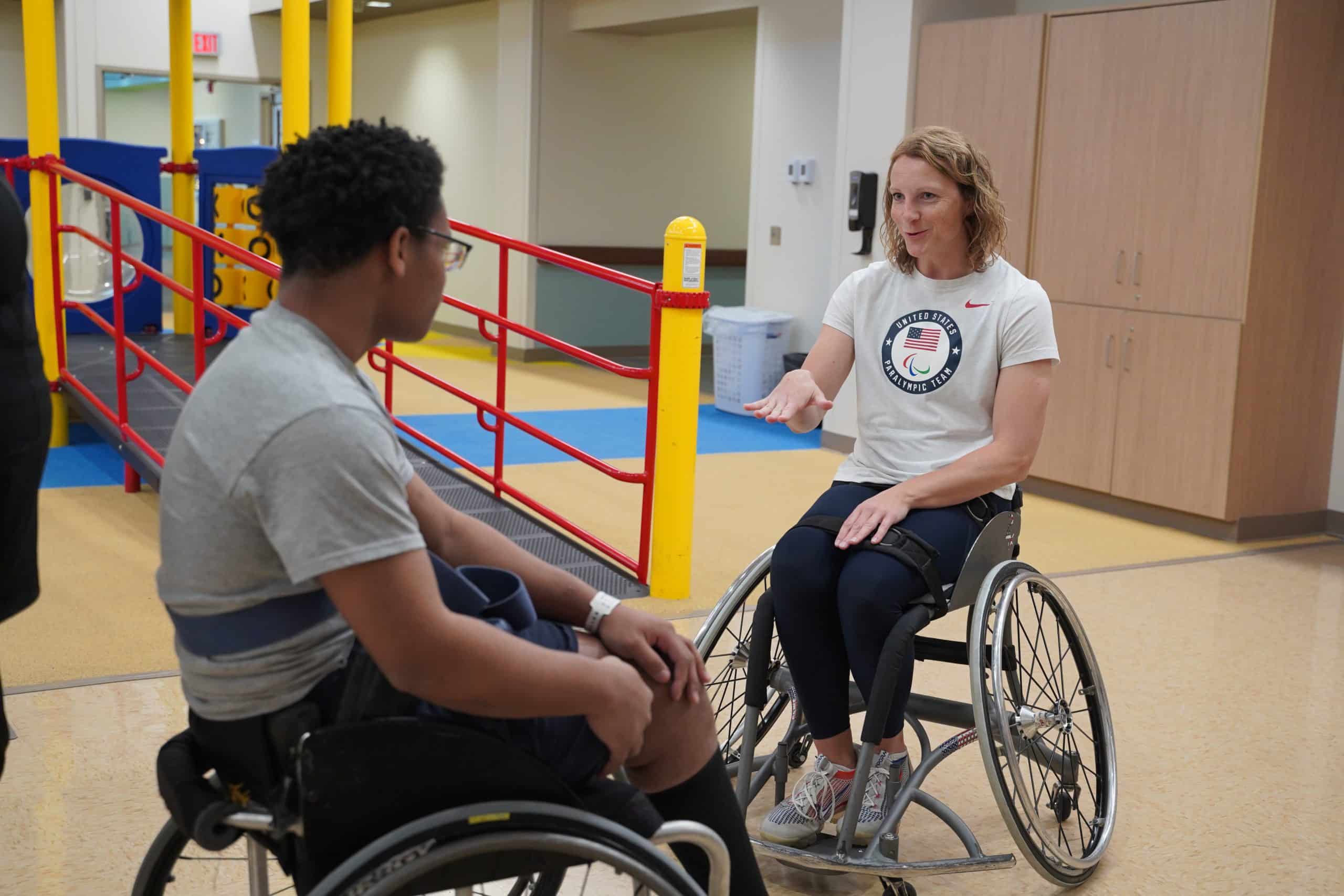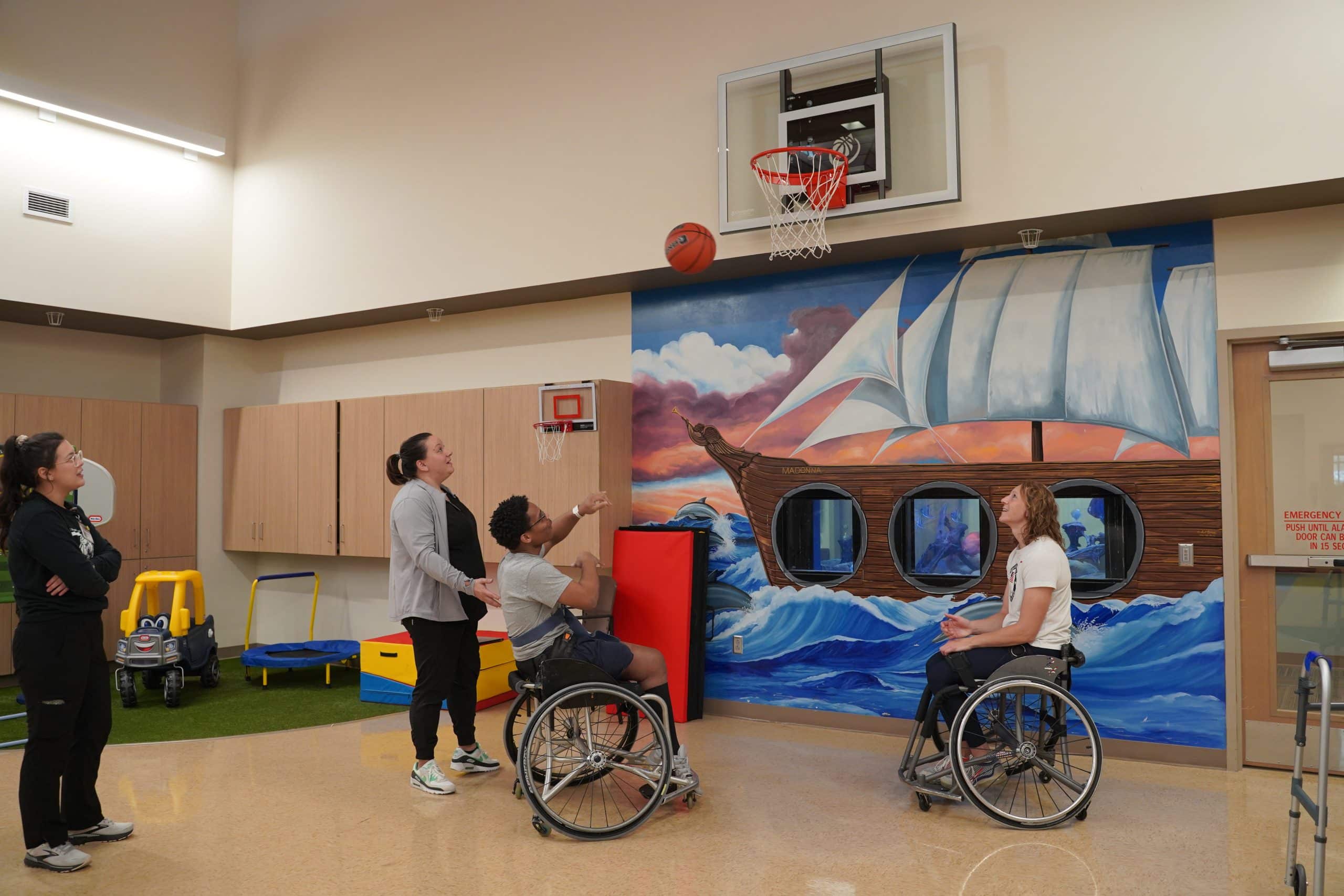Ke’Shon Henderson loves basketball. In 2019, the high-school athlete had several offers to play at the collegiate level and had just signed a letter of intent to play for Judson University in Illinois when a traumatic injury and subsequent stroke changed his life. He came to Madonna Rehabilitation Hospitals Pediatric Program, where Jessie Franks, MA, ACSM-EP, CTRS, a recreation therapist, tried introducing him to wheelchair basketball, but he says he wasn’t ready.
“I couldn’t touch a basketball,” Ke’Shon said. “I couldn’t even look at one.”
Early on in Ke’Shon’s recovery, Franks said it was important to help him navigate through his injury in all aspects of his life. He was focused on relearning self-care, activities of daily living and managing his pain. Recognizing the importance of sports and recreation in his life, she got creative with ways to incorporate fun into his recovery journey.
“When I first met Ke’Shon, he was very deconditioned, had very limited use of his upper extremities and was recovering from a leg amputation,” Franks said. “Keeping in mind his medical complications, we explored various games and activities that could assist him in improving his trunk control and fine motor skills. We started playing UNO and video games. These activities not only helped him physically, it also gave him an outlet for his competitiveness. As he continued to progress we added in weekly community outings and began exploring the topic of playing basketball or another sport competitively or recreationally.”
Four years later, after a final surgical procedure, Ke’Shon returned to Madonna for inpatient therapy. Franks reached out to the Madonna Magic wheelchair basketball team to see if someone could meet with Ke’Shon and show him how to play the adaptive sport. Natalie Schneider, a four-time Paralympian and two-time world champion, volunteered.
Schneider knows firsthand the impact an injury or illness can have on an athlete’s body and mind. In high school in Ord, Nebraska, she was a starter as a freshman and sophomore. After her sophomore season, at the age of 16, she was diagnosed with a cancerous tumor in her right leg. She was told she would never be able to run or jump again. She was devastated.
“It felt like the end of the world,” she remembered. “I thought I would go through chemotherapy and make a quick recovery and be back on the court, and here I am being told I won’t ever play again.”
She regained her ability to walk, but Schneider began looking into adaptive sports because she couldn’t run. She tried seated volleyball and was really talented, but the twisting and turning required hurt her back. When a couple of the guys on her volleyball team asked if she wanted to try wheelchair hoops, Schneider was initially concerned that her ability to walk would disqualify her. Not an issue, they assured her. From the first time she tried it, Schneider fell in love with wheelchair basketball. She was eager to share that love with Ke’Shon.
“Natalie’s story and drive to continue athletic competition after an injury is a huge testament for a fellow athlete like Ke’Shon,” Franks said.


Initially, Ke’Shon was hesitant, because steering an adaptive wheelchair and dribbling a basketball takes a lot of coordination. He also made sure to ask Schneider about specific rules and position players.
“You know how to play basketball, right?” she joked. “Everything is the exact same. Same rules about how long you can be in the paint, what counts as a double dribble or travel, scoring and subbing. The only thing that’s different is that you’re in a chair.”
The pair worked on dribbling, pivoting and shooting. Schneider gave tips on successfully posting up in the paint to shoot and recommended strengthening exercises for arms and core.
While it’s neat to say you’ve met a gold medal winner, Franks is hoping Ke’Shon will take even more from this experience. She says she hopes this plants a seed by giving him resources and allowing him to make personal connections within the wheelchair sports community.
“Recreation, leisure, sports, hobbies, and play go hand and hand with an individual’s quality of life,” Franks said. “After injury or illness, this is no different. Being able to explore a patient’s passion and interests is a large part of recreation therapy. Throughout their recovery, we may make adaptations to meet a patient’s current interests, show them new activities, or utilize a recreation activity as a treatment modality. It’s all about having fun, feeling successful and sparking a light in a patient by showing them what they can do.”
Ke’Shon continues to show improvements in his physical function. He is also working with Judson University to utilize a scholarship he earned in high school so he can start college. He says he’s been more open to the idea of playing the sport he loves again.
“Seeing Keshon’s competitiveness come out again, this time in a sports chair and with a basketball in his hand was just another success in his recovery,” Franks said. “His hard work, determination, competitiveness and dedication will continue to guide him through his future endeavors.”





